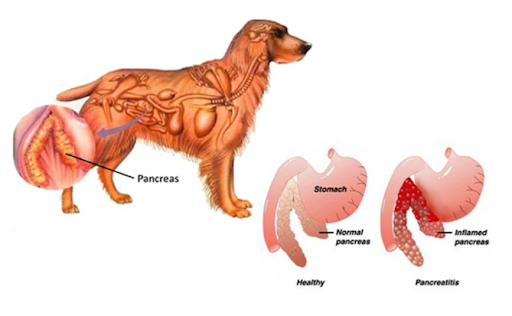This post contains affiliate links, we'll earn compensation if you make a purchase using them at no additional cost to you 😊
If you are a parent of a dog with pancreatitis, it is understandable that you want to know how to comfort a dog with pancreatitis. Many dog parents suffer from this gruesome worry as it is a severe medical condition.

Moreover, even though it is painful, it shouldn’t be the reason for your dog’s discomfort. Plus, there are ways to provide your dog with the utmost comfort with the proper knowledge and treatment.
Hence, in this article, we have covered all the essentials you need to learn about comforting a fog with pancreatitis.
To see the easiest solutions to your one problem, let’s look at the information below.
What Exactly Is Dog Pancreatitis?
The pancreas, an organ next to the abdomen that generates enzymes to aid in food digestion, is affected by pancreatitis. It is a very frequent and sometimes fatal illness that affects dogs.

Moreover, the pancreas creates chemicals like insulin, which control your dog’s glucose metabolism and blood sugar levels. Pancreatitis is the medical term for this organ’s inflammation.
Furthermore, a healthy dog’s pancreas makes digestive enzymes that go into the small intestine, where they stay dormant until they are safely activated and begin to break down food.
These enzymes are rapidly activated when they are produced in a dog with pancreatitis. It is produced while harming the tissues of the pancreas, surrounding tissue, as well as neighboring organs.
How To Help A Dog With Pancreatitis?

By using the following ways, you can comfort your dog in his hard time when he’s suffering from bad pancreatitis pain.
1. Make them a soft bedding
Providing your dog with soft bedding will help him to be comfortable and lay easily. It will help in relieving the pain while giving support to the body.
2. Provide heat Support
Using a heated blanket or hot water pack can be very soothing for your dog suffering from pancreatitis. It helps the dogs relax their muscles and gives them warmth.
3. Feed them small meals
Feeding your dog small portions of meals can help him digest the food easily. Plus, it won’t cause the dog discomfort after stuffing too much food at once.
Also, provide your dog with a low-fat diet, which will help with their stomach issues.
4. Improve their mobility and activeness
Dogs tend to lessen their mobility when they are in severe pain. Hence, it is the dog’s parents’ task to help keep the dog more active and distract him.
5. Distract the dog with treats and toys
When your dog is feeling uneasy and tired of the pain, you can simply distract him by playing with him or treating him with surprises.
You can start by offering a few of his favorite treats or playing games that make the dog move around. These tasks will help the dog engage in activities and occupy their mind instead of pain.
6. Reassure the dog with love
In this difficult time, your dog might feel upset and lonely. They will completely rely on you for any source of comfort, happiness, and relief.
It will also assure them of security and emotional comfort during their painful sufferings.
Extra Support You Can Provide To Your Dog With Pancreatitis
You can use more resources to provide your dog with more support if it is having difficulty controlling its condition.
Try speaking with a dog therapy specialist or veterinary behaviorist who can collaborate with you and your dog to create a detailed therapy plan that covers all of their requirements.
Plus, meeting other pet owners who are going through the same situations, joining an online support community, or going to a pet counseling support group can be a better option.
Your dog will soon be able to recover with the proper medical therapy and mental support!
What Can I Give My Dog For Pancreatitis?
You might be thinking about what you can give your dog if pancreatitis has been detected. Pancreatitis in dogs requires special nutrition to enable them for it to heal.
Hence, you can refer to the following list of nutritional food and supplements for your dog in pancreatitis:
- Chicken-based dog food
- Dog CBD Oil
- Canine Gastrointestinal LF Low Fat
- Weight Control Grain-Free Dry Dog Food
- L.I.D. Limited Ingredient Diets Dry Dog Food
- Super5Mix Dry Dog Food
- Vegan Kibble Dry Dog Food
- Diet g/d Aging Care Turkey Flavor Canned Dog Food
- Potato-Free Fresh Caught Wild Alaskan Pollock
- Reduced Fat Adult Dry Dog Food
- Grain-Free (Low Fat) Formula Dry Dog Food
- Healthy Weight (Adult) Chicken & Brown Rice Recipe Dry Dog Food
- Healthy Weight (Puppy) Breed Grain-Free Wild Salmon & Whitefish Dry Dog Food
- Grain-Free (Reduced Fat) Turkey & Chicken Recipe Dry Dog Food
- Adult Weight Management Turkey & Rice Entree Canned Dog Food
- Healthy Weight (Grain-Free) Chicken and Freeze-Dried Raw Pieces
- Grain-Free Dehydrated Dry Food
- Healthy Weight Chicken and Sweet Potato Recipe
- Pancreas Inflammation & Flow Support Dog Supplement
Is wet or dry food better for dogs with pancreatitis?
When feeding your dog after pancreatitis, consider the advice of experts on what foods and how to prepare them. Give your dog food that has less than 10% fat in it.
In order to keep the fat content as low as possible, we advise feeding them frequently and in small amounts. When giving a wet meal, use caution.
Symptoms of canine pancreatitis!
The signs of pancreatitis should be recognized and diagnosed within time before the early intervention to manage and treat it.
The common symptoms of canine pancreatitis are as follows:
1. Loss of appetite:
Your dog might eventually refuse to eat anything and might start showing less interest in having food at all. Therefore, if your dog starts showing symptoms like not eating, pushing their food plate away, and getting irritated with the smell of food altogether, it’s time to take them to a doctor.
2. Vomiting:
Frequent vomiting that is mixed with yellow bile is a significant sign that your dog is suffering from pancreatitis. This is one of the primary symptoms to detect pancreatitis in dogs easily.
3. Pain in Abdomen
The abdominal pain dogs face doesn’t always mean that a severe condition like pancreatitis causes it. Hence, it’s not mostly reported by vets. This pain is often misunderstood due to the inability to understand what’s wrong with dogs.
However, if your dog looks bloated or hunched back while being uncomfortable, you can tell that it’s a sign of pancreatitis. Therefore, once you get an idea of the severity of the pain, you must get the tests done by a vet without risking it and mistaking it for normal belly pain.
4. Diarrhea
Dogs who suffer from diarrhea for more than two days should be taken to a vet right away and should be checked thoroughly by running tests that cure diarrhea.
5. Lethargy
Suppose a dog has been feeling lethargic and out of motivation to get and move from his spot, along with showing signs like weakness, listlessness, and simply feeling unwell. In that case, it is a major sign of the dog being sick or suffering from pancreatitis.
6. Fever
A dog’s normal body temperature is 99.5F to 102.5F. So, if your dog’s body temperature exceeds the limit of the normal temperature after testing from the thermometer, which is specially made for pets, your dog has a fever for sure.
Also, make sure to check the fever on the thermometer as instructed. Your pup might show signs of fever, and you should definitely take the fever and other signs like red eyes, warm ears, cough, shivering, or even a drier nose.
If the dog’s temperature is around 103F, that indicates the dog has a fever. However, if the temperature goes around 106F or more than that, it will harm your dog with organ damage or might even kill the dog.
Therefore, dogs with fever should be directly taken to be checked by their vet.
7. Dehydration:
Panting, sunken eyes, dry nose, and thick spit are symptoms of this. You can use a gentle grip to lift and lightly release a small portion of skin near your dog’s shoulder blades to see whether they are dehydrated.
Observe as their skin returns to its natural state. Your dog’s skin should return to normal pretty fast if they are properly hydrated. Their skin will require longer to rehydrate if they are dehydrated.
Signs of the Pancreatitis getting worse!
In the case of your dog’s health getting worse day by day, you need to take the dog to the vet if the dog is suffering through the following things:
1. A bloated belly or hardened belly.
2. Untreatable vomiting and diarrhea, which are getting over in 24 hours, could also mean worsening pancreatitis conditions.
3. If your dog is facing breathing issues or even swallowing saliva or food, it means an emergency situation.
4. Your dog having seizures more frequently than before is a major sign.
5. Not being able to drink at all.
6. Not getting up on the legs and standing properly.
What causes dog pancreatitis?
Pancreatitis in dogs frequently appears to strike out of nowhere. Furthermore, you and your veterinarian might be unable to determine the cause. However, veterinarians know a few factors that induce pancreatitis in dogs or increase their risk of developing it.
Among them are:
1. Fatty Diet:
A diet heavy in fat is the most frequent cause of pancreatitis in dogs, particularly when they consume large amounts of fatty food at once.
For example, the day following Thanksgiving is one of the most hectic times of the year for emergency veterinary visits related to pancreatitis in the United States. This is the season when dogs eat a great deal of fatty meal scraps or are given them as treats.
2. Eating anything in the past:
Dogs should not eat a lot of items that are safe and nutritious for humans. A number of these foods have the potential to cause major health issues, such as pancreatitis.
Chocolate, macadamia nuts, garlic, onions, cinnamon, and anything containing xylitol (a sugar substitute added to processed foods) should never be given to your dog.
Many dogs with pancreatitis have consumed a lot of table scraps or food that was picked up from the trash.
3. Being overweight:
Cushing’s syndrome or other endocrine problems, including hypothyroidism, can cause a problem related to pancreatitis. The condition known as Cushing’s syndrome happens when your dog’s adrenal glands produce more cortisol than is necessary for them.
4. Diabetes:
Severe blunt trauma, for example, is a result of being struck by a car on roads. Certain parasitic diseases include leishmaniosis (produced by the Leishmania protozoa) or babesiosis (induced by ticks).
5. The Genes of your dog:
Certain breeds, such as Miniature Schnauzers, Yorkshire Terriers, Cocker Spaniels, Dachshunds, Poodles, sled dogs, and several other toy or small terrier breeds, appear to be more susceptible to pancreatitis than others.
6. Intake of toxins:
If your dog is continuously taking toxins through meals or medicines, it also causes pancreatitis development in dogs.
Drugs and toxins that cause the most damage are – Cholinestiraz Inhibitors, Calcium supplements, Potassium bromide and phenobarbital, L-asparaginase, Estrogen, Aspirin, Azathioprine, Thiazide diuretics, and Vinca alkaloids.
Diagnosis of Dog Pancreatitis!
Blood testing is used to identify pancreatitis in the majority of instances. Your veterinarian will probably perform blood tests to check for elevated levels of pancreatic enzymes and white blood cells caused by inflammation.
Recent advancements in testing can offer a quick diagnosis. In particular, your veterinarian can quickly verify whether pancreatitis is the reason for your dog’s symptoms with the Specific Canine Pancreatic Lipase test or SPEC-CPL test.
Lipase is one of the enzymes the pancreas produces; if this enzyme is increased, it confirms the issue.
Most of the tests that are done to diagnose dog pancreatitis are listed below:
- A physical examination that takes note of your dog’s temperature, heart, belly, and gums.
- Tests on the bloodstream to assess how much pancreatic enzyme production occurs in your dog. More specifically, your dog most likely has pancreatitis if they test positive for pancreatic lipase immunoreactivity (PLI).
- Ultrasounds or X-rays can help rule out other illnesses that might be causing your dog’s symptoms.
- A pancreatic biopsy is performed on your dog using a small needle to check for infection and edema.
What is the treatment of Pancreatitis in Dogs?
Treatment can begin as soon as a diagnosis has been made. It’s about letting the body recover by giving the pancreas a break. Dogs that vomit are usually given anti-nausea medicine and are not allowed to eat again until the vomiting stops.
Fluid therapy is usually necessary in these circumstances to keep the patient’s hydration levels at proper levels.
Your veterinarian will give your dog highly digestible, low-fat food if they are not throwing up. To assist in managing the pain, they could also give your dog medicine.
Anti-inflammatory medications or antiemetics (to stop vomiting) might be needed in more serious situations.
Your veterinarian may also recommend probiotics for a period of time after prescribing antibiotics if they think an infection has already begun in order to reestablish the proper balance of gut flora.
Hospitalization is usually necessary for several days in most pancreatitis cases to control the symptoms. Your veterinarian will use strong fluid therapy along with medication to counteract shock in life-threatening cases.
The vet will advise you to follow a low-fat diet and take supplements after the medication has taken effect in order to help avoid future flare-ups.
How to prevent Pancreatitis in dogs?
Monitoring your dog’s food consumption is the most crucial thing you can do to protect them against pancreatitis. Avoid giving them an excessive amount of fattening food or anything else they shouldn’t be eating.
Give them no leftovers from the table as snacks. Try to prevent them from getting into the trash, particularly the kitchen trash.
Additionally, keep all vitamins and medications out of their reach, particularly if you know they’ll consume anything that falls to the ground or is on low-lying tables.
Here are a few supplements that could help shield your dog from pancreatitis:
1. Supplement of digestive enzymes.
The digestive enzymes might lessen the amount of work your dog’s pancreas has to undertake to aid in food digestion.
They can be obtained over-the-counter or with a prescription. Ask your veterinarian whether they believe this will benefit your dog, as it might not benefit all dogs.
2. Supplements containing fish oil:
Despite being heavy in fat, they mostly help lower your dog’s cholesterol. Some dogs may develop pancreatitis as a result of high blood lipids. Consult your veterinarian about trying them if your dog has elevated cholesterol levels.
According to the research I’ve done on fish oil for dogs, dogs suffering from acute pancreatitis may benefit from ingesting 1,000 mg of fish oil for every 10 pounds of body weight.
Related read;
Conclusion on Comforting A Dog With Pancreatitis
Giving your dog the medical attention and comforting measures required to manage his condition is the main objective of learning how to comfort a dog with pancreatitis.
You can quickly get your dog back on his feet and feel better with the correct combination of medication, nourishment, and comfort measures.
Always remember that a supportive relationship during this trying period is essential for you and your dog. Your dog will quickly return to its normal self with the proper treatment.
FAQs
Most mild pancreatitis illnesses in dogs need a short hospitalization of 2 to 4 days. Your dog should get back to normal within a week or two of their release.
However, a minimum of two weeks in the hospital may be necessary for difficult pancreatitis situations.
Your dog’s poop may have changed for a number of different reasons. Nonetheless, Your dog’s poop can turn light yellow, appear greasy, and smell bad if they have chronic pancreatitis.
A dog with pancreatitis shows some clinical signs and symptoms, like severe lethargy, stomachaches, and continuous vomiting.
Dogs whose meals include highly processed food which includes high fat and less protein are more at risk of getting pancreatitis once in their life.


